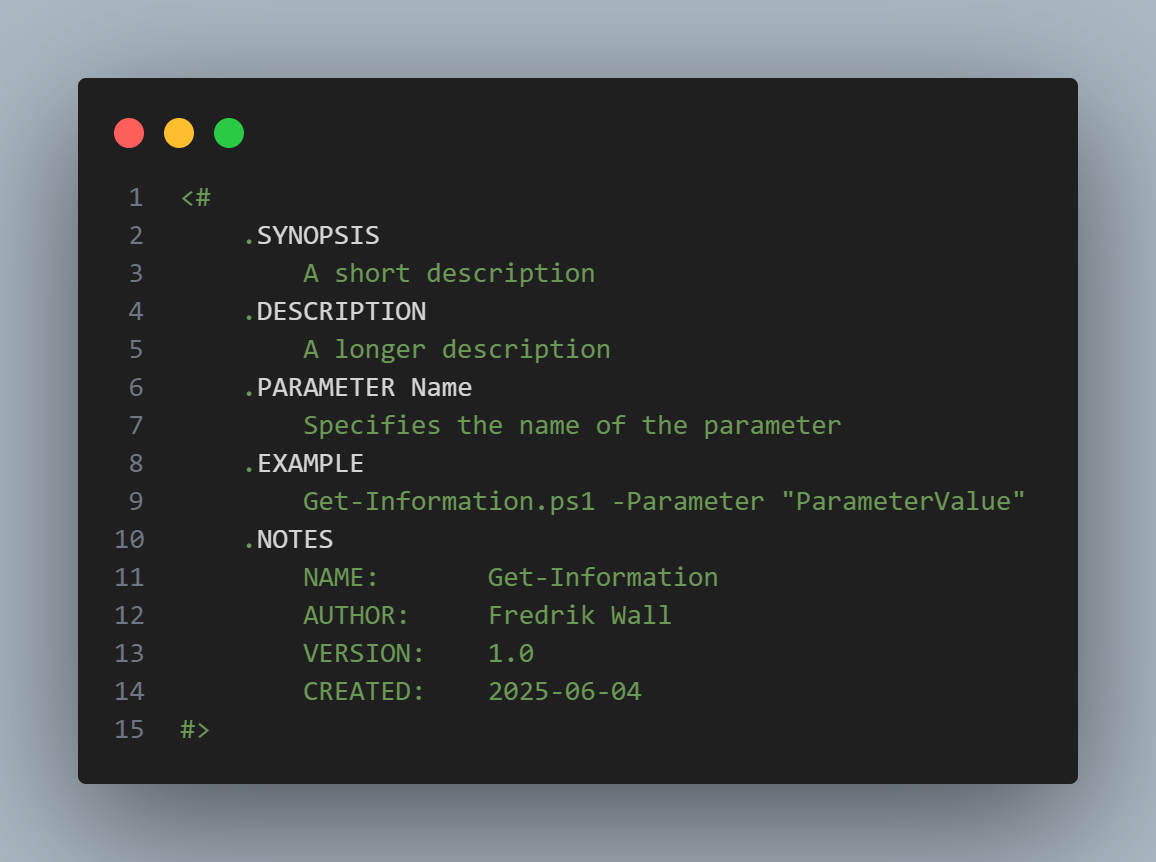This is my first User Snippet posted for Visual Studio Code.
I know there is a default snippet included with the PowerShell extension.
All the code and information provided on this website are offered “as is” without any guarantees or warranties of any kind. Although the code and information are tested, we do not warrant that the code is error-free or that it will meet your specific requirements. Use the code at your own risk. We disclaim all liability for any damages or losses arising from the use or inability to use the provided materials.
However, I want to add additional information and have it inserted automatically.
To access the default Comment-Based help snippet, simply type comm in Visual Studio Code, and IntelliSense will display the comment-help snippet, as shown in the image below.

This option is better than not using Comment-Based Help for your script or function.
It’s great! Everything required for Comment-Based Help is included.
HOWEVER…
<#
.SYNOPSIS
A short one-line action-based description, e.g. 'Tests if a function is valid'
.DESCRIPTION
A longer description of the function, its purpose, common use cases, etc.
.NOTES
Information or caveats about the function e.g. 'This function is not supported in Linux'
.LINK
Specify a URI to a help page, this will show when Get-Help -Online is used.
.EXAMPLE
Test-MyTestFunction -Verbose
Explanation of the function or its result. You can include multiple examples with additional .EXAMPLE lines
#>I always include name, author, version, and date in the Notes section, and the script name in the Example section.
But I don’t want to type this information manually every time.
I’m a bit lazy!
Here is my standard Comment Based Help:
<#
.SYNOPSIS
A short description
.DESCRIPTION
A longer description
.PARAMETER Name
Specifies the name of the parameter
.EXAMPLE
Get-Information.ps1 -Parameter "ParameterValue"
.NOTES
NAME: Get-Information
AUTHOR: Fredrik Wall
VERSION: 1.0
CREATED: 2025-06-04
#>I have also created a PowerShell user snippet for this.

There are many variables available for Snippets in Visual Studio Code, and I use several of them.
Example – To get the PowerShell script name, I use $TM_FILENAME.
Name – For the script name without the .ps1 extension, I use $TM_FILENAME_BASE.
Author – This one was a bit tricky to automate. I use ${WORKSPACE_NAME}.
Created – I use ${CURRENT_YEAR}-${CURRENT_MONTH}-${CURRENT_DATE} here. You can adjust this format to match your country’s date style.
All available variables can be found on the User Defined Snippets page:
https://code.visualstudio.com/docs/editing/userdefinedsnippets
To be able to get the automatically Comment Based Help with all information as above you first of all need to add this to the PowerShell User Snippet JSON file.
"Comment Based Help": {
"prefix": "Comment Based Help",
"body": [
"<#",
" .SYNOPSIS",
" A short description",
" .DESCRIPTION",
" A longer description ",
" .PARAMETER Name",
" Specifies the name of the parameter",
" .EXAMPLE",
" $TM_FILENAME -Parameter \"ParameterValue\"",
" .NOTES",
" NAME: $TM_FILENAME_BASE",
" AUTHOR: ${WORKSPACE_NAME}",
" VERSION: 1.0",
" CREATED: ${CURRENT_YEAR}-${CURRENT_MONTH}-${CURRENT_DATE}",
"#>"
],
"description": "Comment Based Help By PowerAdmin.se"
}The easiest way to open the JSON file is by using Shift+Ctrl+P (Command Palette) and searching for Snippets: Configure Snippets. Then select powershell.json (PowerShell).
Next, insert the code above between the { and }.
If you already have other snippets, add a , after the last one before pasting the new code. Save the file afterward.
Now, you will have a snippet that inserts this information automatically…
…as long as you save your script first with your chosen name.
In my example: Get-Information.ps1
Finally, go to File and select Save Workspace As with your name to set your name as the Author.

This was a brief guide, but it provides helpful insights that assist me every single day without fail.


Leave a Reply